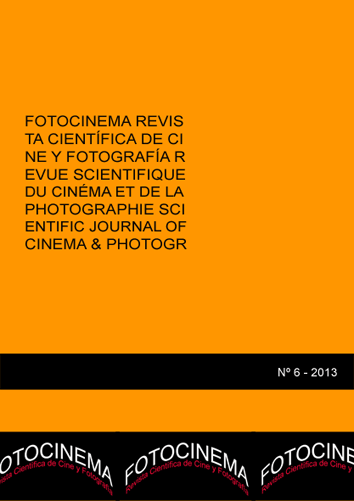A infindável procura de um traço identitário: existirá uma estética feminina?
DOI:
https://doi.org/10.24310/Fotocinema.2013.v0i6.5910Abstract
Resumo: No âmbito das teorias feministas do cinema, e dos estudos fílmicos em geral, algumas questões têm sido levantadas ao longo das últimas décadas, nomeadamente no que diz respeito à exigência de uma maior representatividade feminina no mundo da realização e produção cinematográficas. Sendo o olhar do espectador, como Laura Mulvey sugeriu, pressupostamente masculino, treinado por realizadores com fantasias e tendências voyeuristas homogéneas, a questão seguinte seria inevitável: poderá este mesmo olhar assumir características distintas, quando mediado por uma mulher? Poderá a arte, ao contrário dos anjos, ter sexo? Existirá, neste sentido, uma “estética feminina”, como Silvia Bovenschen, em artigo homónimo, publicado em Setembro de 1976, procura antecipar? Procurá-la não implicará um aprofundar de estereótipos associados à feminilidade e à masculinidade, todos eles redutores, segundo o ponto de vista de Michel Foucault e Judith Butler, bem como a atribuição de um certo carácter de exotismo, pela falta de representatividade nos circuitos artísticos? Enunciando e debatendo os principais argumentos dos autores mencionados, propomo-nos, no presente artigo, responder às questões colocadas.Palavras-chave: voyeurismo; espectadora; ausência; receptividade; identificação.
Abstract: In the context of feminist theories of cinema, and film studies in general, some questions have been raised in the past few decades, concerning the need for a greater representation of women in the world of film making and production. Accepting the idea of a viewer gaze, as Laura Mulvey suggested, supposedly male, trained by directors with fantasies and uniformed voyeuristic tendencies, the next question is inevitable: might this gaze have different characteristics when mediated by a woman? Can the art, unlike the angels, have sex? Is there, in this sense, a “feminine aesthetic”, as Silvia Bovenschen, on an article with the same name, published in September 1976, looks forward to anticipate? To look for it does not imply a deepening of stereotypes associated with femininity and masculinity, all reducers, according to the point of view of Michel Foucault and Judith Butler, as well as the assignment of a certain exoticism’ character, motivated by the lack of representation in the art circuit? Outlining and discussing the main arguments of the authors above mentioned, we propose, in this paper, to answer these questions.
Keywords: voyeurism; female spectator; absence; receptivity; identification.
Resumen: “Las mujeres son diferentes, y una manifestación natural de esta diferencia (nota bene!) es precisamente el hecho de que son incapaces de producir arte.” (Bovenschen, 1976: 115).
Haciéndose eco del paralelismo ya realizado por Simone de Beauvoir en el ensayo El segundo sexo, Silvia Bovenschen vuelve, en un artículo publicado en 1976 que nos proponemos discutir aquí, a la asociación asumida entre una perspectiva descriptiva masculina y la verdad absoluta. En su opinión, el dominio de la producción artística por el género masculino habrá originado una inaccesibilidad y una extrañeza relativas a la otra mitad de la población, que se denuncia por el carácter de exotismo que muchos críticos votaron a los pocos, y de cierta forma lejos entre si mismos, objetos culturales producidos por las mujeres, a lo largo de la historia. Otra consecuencia natural de este fracaso, descrito por el uso del término déficit, importado del lenguaje economicista, todavía sería, a nuestro juicio, una segregación de la dicha producción en una sola clase: una escritura femenina, una mirada femenina, un rasgo femenino. Con la restricción, la incertidumbre se multiplica: la escritura femenina es la que centra su atención en mujeres fuertes y decididas, la que demuestra una sensibilidad y capacidad de observación característica de un género, o la que construye una narrativa entrecruzada, por la sociológicamente establecida capacidad de realizar múltiples tareas asociadas al mismo sexo?
Downloads
Metrics
Downloads
Published
How to Cite
Issue
Section
License
All contents published in Fotocinema Revista científica de cine y fotografía are protected under the Creative Commons Attribution-NonCommercial-ShareAlike 4.0 International (CC BY-NC-SA 4.0) license. All about this license is available in the following link: <http://creativecommons.org/licenses/by-nc-sa/4.0>
Users can copy, use, redistribute, share and exhibit publicly as long as:
- The original source and authorship of the material are cited (Journal, Publisher and URL of the work).
- It is not used for comercial purposes.
- The existence of the license and its especifications are mentioned.
There are two sets of authors’ rights: moral and property rights. Moral rights are perpetual prerogatives, unrenounceable, not-transferable, unalienable, imprescriptible and inembargable. According to authors’ rights legislation, Fotocinema. Revista científica de cine y fotografía recognizes and respects authors moral rights, as well as the ownership of property rights, which will be transferred to University of Malaga in open access. The property rights are referred to the benefits that are gained by the use or the dissemination of works. Fotocinema. Revista científica de cine y fotografía is published in an open access form and it is exclusively licenced by any means for doing or authorising distribution, dissemination, reproduction, , adaptation, translation or arrangement of works.
Authors are responsable for obtaining the necessary permission to use copyrighted images.













13.png)




